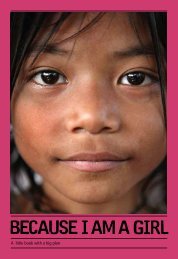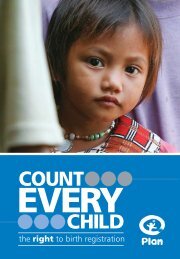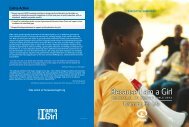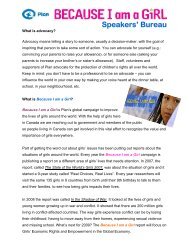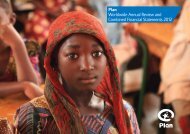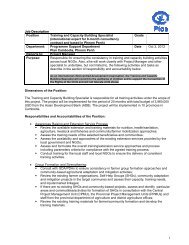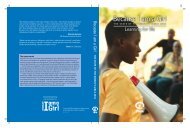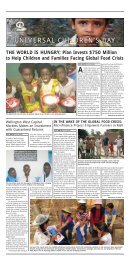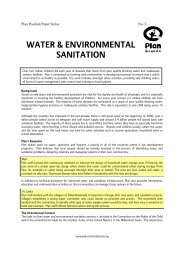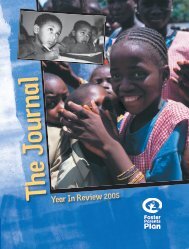Girls executive summary - Plan Canada
Girls executive summary - Plan Canada
Girls executive summary - Plan Canada
- No tags were found...
You also want an ePaper? Increase the reach of your titles
YUMPU automatically turns print PDFs into web optimized ePapers that Google loves.
Because I am a Girl:The State of the World’s <strong>Girls</strong> 2007Executive Summary‘Because I am a Girl: The State of the World’s <strong>Girls</strong> 2007’ is the firstin a series of annual reports published by <strong>Plan</strong> examining the rights ofgirls throughout their childhood, adolescence and as young women.This report provides a comprehensive examination of the situation ofthe world’s girls. Subsequent reports in the series will focus on specificviolations of girls’ rights and the mechanisms for securing them.“This study shows our failure to make an equal, more just world has resulted inthe most intolerable of situations. To discriminate on the basis of sex and genderis morally indefensible; economically, politically and socially unsupportable. Noneof the Millennium Development Goals will be achieved without gender equality. We cannot letanother minute go by without acting decisively and urgently. Unless we do, we will be condemning millions of girlsto a life of poverty and hardship.” Graça Machel<strong>Girls</strong> are getting a raw deal. They face the double discrimination of their gender and their age, and in many societies remainat the bottom of the social and economic ladder. In theory girls have the same rights as their brothers, but in practice in manyparts of the world, they cannot access these rights.A Better Deal for <strong>Girls</strong> : An Eight Point Action <strong>Plan</strong>This action plan is a long-term agenda for girls’ rights, covers broad areas of action and is largely country specific.1. Listen to girls and let them participate. <strong>Girls</strong> have the potential to articulate and secure their rights. This report hasshowcased a few of the voices of young women who are emerging from very difficult situations. The voices of girls andyoung women need to be heard.2. Invest in girls and young women. Adequate resources must be made available at all levels in order for girls and youngwomen to secure their rights. Their needs are often different from those of older women and from boys and men.3. Change and enforce the law. In many countries, discriminatory laws and practices relating to girls and young womenprevail. Where this is the case, they should be reformed with a human rights perspective and clearly embedded incommunity action. Where laws to protect and support girls and young women already exist, they must be enforced.4. Change attitudes. The situation of girls is more likely to improve and at a faster pace if attitudes about gender equality,including those of boys and men, change. As long as women are considered second-class citizens, girls and young womenwill never be able to achieve their full potential.5. A safety net for girls. The poorest and most vulnerable girls and their families would benefit from comprehensive socialsupport which could include regular and predictable grants, scholarships or stipends to encourage girls to go to school andsupplementary nutrition.6. Get specific data on girls. It has become clear during the course of researching this report that more data on girls andyoung women specifically is urgently needed. Statistics and material are collected either on children or on women in general.National data disaggregated by sex and age has to be collected and used by policy makers.7. Take a life cycle approach. This report has shown that taking a life-cycle approach to improving the rights of girls meansaddressing discrimination at every stage from birth – or even before birth – until they are grown women. This has enabledus to see the pervasiveness of issues like violence throughout the life cycle of a girl, and to identify the critical points ofvulnerability in her life.8. Learn, document and share good practice. The research for this report has shown just how little we really know aboutthe lives of young women and how best to improve them. Systematic documentation and learning on best practice in relationto girls’ rights is needed. Subsequent reports in this series will take specific areas and look at them in more detail.www.plancanada.ca/becauseiamagirl<strong>Plan</strong> <strong>Canada</strong> 95 St. Clair Avenue West Toronto M4V 3B5 Tel: 416 920 1659 plancanada.ca
<strong>Girls</strong> can face discrimination even before they are born – there are an estimated 100 million girls and women missingbecause of the growing practice of female foeticide in some parts of the world. Discrimination permeates each stage of agirl's life, at home, at school and at work. Preferential feeding of boys leads to malnutrition for girls which has lasting physicaland mental effects. <strong>Girls</strong> have less opportunity to be educated, are more at risk of gender-based violence, and face greaterrisks of economic and sexual exploitation. The fact that girls have less control of sexual decisions means that, in Sub-SaharanAfrica, two-thirds of 15 -19 year olds newly infected with HIV are girls.The persistence of gender discrimination across all societies means that the odds really are stacked against girls, particularlythose from the poorest and most marginalised communities, and in times of insecurity and disaster. These girls have almost nochance of escaping the cycle of poverty, discrimination and exploitation in which they find themselves.The distinct lack of progress by girls, if it continues, will in fact prevent the world’s governments from meeting theMillennium Development Goals. <strong>Girls</strong> have a real contribution to make as daughters, mothers, wives, sisters, students and alsoas workers. No country has yet emerged from poverty without investing in education for all and there is clear evidence thatinvesting in girls and their mothers improves every other indicator of well-being.Despite the gains made in gender equality and women’s rights in recent years, and despite international legislation designed topromote equality and protect girls, the world has yet to deliver its commitment to today’s girls. Several pieces of internationallegislation, for example, the Convention on the Elimination of All Forms of Discrimination Against Women (CEDAW) and the UNConvention on the Rights of the Child (UN CRC), prohibit gender discrimination. Most of this international legislation is translatedinto national law but these are not necessarily enforced at national level; a striking example of this is legislation that should protectgirls from early marriage. At the same time, the discriminatory laws and customs that still exist tend to be applied more sharply.Central to achieving equality for girls is their participation in decision making and public life. There are countless examplesof individual girls, groups of girls and large movements of girls and women taking on the challenge of tackling discriminationand securing their rights. These initiatives need support.Why Do <strong>Girls</strong> Face Discrimination?<strong>Girls</strong> face the double challenge of being female and being young, which can result in them having little opportunity to makedecisions about their lives. Discrimination against girls is grounded in a series of traditions and norms, based on the assumptionthat biological differences between females and males justify that girls are denied access to rights, opportunity and voice. It isboth systematic and widely tolerated. Emerging research commissioned by <strong>Plan</strong> in West Africa shows that, its manifestations,such as gender based violence, are deeply rooted in the inequalities between women and men, and girls and boys.<strong>Girls</strong> face discrimination in five crucial areas:• Invisibility. This includes female foeticide, lack of birth registration, and public environments which discourage their visibilityand participation.• Capacity. This affects the ability of girls to benefit from all of their rights. <strong>Girls</strong>’ capacity can be impaired by educationalcurricula, which reinforce negative gender stereotyping, and by preferential access to nutrition for boys within the family.• Physical and mental discrimination. This includes gender based violence and trafficking, temporary marriages, and judgementalattitudes to the sexual activity of girls limiting their access to preventative measures and health services.• Family and household responsibilities. This includes discrimination caused by lower minimum ages of marriage for girls, andthe sexual and economic exploitation of girls in work, in particular child domestic workers.• Local and national customs and traditions. This includes embedded religious, judicial and secular traditions, which allow forinequality in inheritance and the creation of status offences discriminating against girls in the legal system.Achieving gender equality and a better deal for girls requires a challenge to deep rooted attitudes across societies, and anew momentum for investing in girls’ education. An ambitious programme in Haryana in India aims to increase the valueplaced on girls by their families and prevent early marriage. A small sum of money is put into a savings account by localgovernment for each girl at birth. If she is still unmarried at the age of 18, she can collect the amount plus the years of interest.The Early YearsDiscrimination against girls begins at birth, or earlier, through attitudes and patterns in behaviour passed down throughgenerations. As this report demonstrates, the lower social status of a girl can have serious consequences for her health andwell-being as she grows up and has children herself. By age five, most girls and boys have already internalised the gender roleexpectations communicated to them by their families, schools, the media and society as a whole. The next generation is thenlikely to repeat the same cycle. Despite progress in securing a number national and international legal standards designed toprotect and promote the rights of girls, cultural and social beliefs about gender and the value of girls and boys have beenmuch more difficult to overcome.In many countries, particularly in South Asia and China, the birth of a boy is something to be celebrated and the birth ofa girl a cause for commiseration, particularly where a marriage dowry requires the parents of daughters to make a financialoffering. Much of this is to do with the fact that in some cultures, a boy will grow up and look after his parents, while a girlwill be married into another family, and is therefore seen as a financial burden to her own parents.The family is where children first learn about their potential. It is here that millions of girls are socialised to believe thatthey have a lower social status than boys. Women are themselves the keepers of much of the knowledge passed on to girlsand boys in their early years. In order to ensure that girls can access their rights and have the same opportunities as boys,changes of attitude within the family are necessary.
The Challenges of AdolescenceThe social status that a girl occupies has consequences in all areas of a girl’s life, and in particular during her transition fromgirlhood into womanhood. This is a time of making the choices which will shape the remainder of her life. Education can makea huge difference to the lives of girls, particularly if they have access to quality, free, girl-friendly educational facilities. A host ofacademic studies, national and international initiatives and projects on the ground have proved the case for girl’s education.Recent studies show a striking correlation between under-five mortality rates and the educational level attained by a child’s mother.Progress in this area has been notable – recent progress in enrolments at primary school level has benefited girls in particular.The reality for millions of girls in some of the world’s poorest countries is that they have to spend much more time ondomestic, non-economic work than boys, and have less time for education and recreation. The rites of passage that determinethe transition from girlhood to womanhood can themselves be challenging for girls. Female genital cutting and other initiationrites are customs which violates the rights of girls. Marriage while still in her teens, or younger, and early pregnancy usuallyhas a detrimental impact on a girl’s right to education and to fulfilling her potential.“To stop this inhuman attitude towards girls, there should be stringent laws against the practice of child marriages, andboth the governments and the civil societies should initiate awareness raising campaigns at every community on genderequity and the evil consequences of child marriages.” B. Savitha, aged 14, IndiaThe family is the place where girls and boys should feel safe, and where they learn how to grow into mature and responsibleadults, where they form their first relationships and hopefully follow the positive role models shown by their parents. But it isalso the place where millions of children, especially girls, face violence and abuse. Much of this violence is gender-based andperpetrated mainly by men against girls and women.As a girl moves into adulthood, her education or lack of it, will have a significant impact on several areas of her life. Thereis clear evidence that knowledge, information and self esteem help girls to protect themselves from HIV infection, exploitationand hazardous child labour. Her children are more likely to be healthy and to go to school themselves if a young woman iseducated. For example, children with unschooled mothers are 4.8 times more likely to be out of primary school in Venezuela,4.4 times more likely in Suriname, and 3.4 times more likely in Guyana. An educated young woman also has a better chanceof earning an income, which has a positive effect on her family and on the economy. Studies have shown that as a country’sprimary enrolment rate for girls increases, so too does its gross domestic product per capita.What works?Girl-friendly Education• Promoting child protection in schools ensures a safe environment for girls in particular• Ensuring that schools are secure, that girls do not have to spend time alone with male teachers, that lighting is good inand around the school, and that schools are close to children’s homes.• Stamping out sexual harassment and abuse in schools, whether by teachers or peers.A recent evaluation in Guatemala of a girls’ education programme implemented across Latin America showed that girlswho attended these schools wanted to continue to study and were less inclined to get married at an early age.Becoming a Young Woman<strong>Girls</strong> and women are healthier than they have ever been. Over the past few decades, life expectancy has increased by morethan 10 years and fertility rates have decreased. In Latin America, in particular, some of the health gains for girls and womenhave been notable. But more than half a million girls and women – 99 per cent of whom live in countries of the South – stilldie unnecessarily every year from pregnancy-related causes. <strong>Girls</strong> and women are more vulnerable than men to the risk ofSTIs including HIV, as they are less likely than men to have control over when and how they have sex. Adolescent girls in therich world suffer from mental health problems such as anorexia and self-harming. These girls face growing pressure abouttheir appearance based on a gendered ideal of a young woman’s acceptability in society.The last decade has also opened up a multitude of possibilities for young women, particularly in the rich and the rapidlyexpanding economies of the world. More young women are in paid work than ever before, and in some countries they areentering professions that were traditionally regarded as ‘men’s jobs’. However, the reality for the vast majority of girls andyoung women is their invisible and undervalued contribution to the economy, both in cash and in kind. 70 per cent of the1.5 billion people living on $1 a day or less are female. <strong>Girls</strong> and women who work are generally doing so in addition to thehours they put in at home. Their contributions include unpaid household work, traditional (female) work such as the devdasior temple prostitution system in India where girls are sent away from the family home to work as prostitutes, and paid workto mitigate the economic vulnerability of being poor. <strong>Girls</strong> are more at risk of falling into exploitative situations, thereforeefforts are needed to protect them from harmful labour.“It is not only the government and NGOs who can take care of us but we ourselves must find ways to protect our rights.Let us all be aware of the problems we are facing now. <strong>Girls</strong>, don’t let other people abuse you. Stand up! And fight for yourright!” Stefanie, aged 13, Philippines
There are some groups of girls who have to counter double or triple discrimination, and who find themselves in especiallydifficult circumstances. Sometimes this is simply because they come from a family living in poverty and may end up survivingon the street. Sometimes it is because they come from a group that is discriminated against such as an indigenous group, orthose from a minority ethnic or racial background, or have a different sexual orientation. Sometimes it is because a youngwoman is disabled in some way. Or it can be due to circumstance – living in a conflict area, becoming a refugee or a displacedperson, or being orphaned. In all these situations, girls and young women have a particularly difficult time because of theirgender.What works?Where governments have introduced programmes for the poorest and most vulnerable families to benefit from a smallinjection of extra, regular and predictable resources directly into the hands of mothers or grandmothers, this has impactedpositively on the welfare of girls. The Mexican government’s Oportunidades programme has had a greater impact on girls’school enrolment than boys. The Bangladesh cash-for-education programme has resulted in a 20 – 30 per cent increase inprimary school enrolment, with both girls and boys involved likely to stay in school up to two years longer than other children.Towards Equality for <strong>Girls</strong>“<strong>Girls</strong> should get organised in each village and insist on getting equal opportunities for education as well as recreation andin the decision making in the family.” Vandana, aged 15, IndiaExamining the challenges faced by girls through a human rights lens exposes a series of persistent violations across the lifecycle of a girl. <strong>Plan</strong> is proposing an eight point action plan which calls for increased participation of girls and young women,more investment in girls, changing and enforcing the law, changing attitudes, the need for a safety net for the poorest girls,the need for better data on girls, and the importance of taking a life cycle approach and documenting best practice.Improvements in equality between boys and girls come about when there is political will, cultural change and when societyis committed to gender equality. It is time to support these efforts; to ensure that when a child is born she is not discriminatedagainst simply because she is a girl.Key Facts Across a Girl’s Life Cyclemore than all the girls in North America and Europe.• <strong>Girls</strong> will not remain in school if they are subjected toabuse and violence, and lack adequate sanitation facilities.• Despite gains for girls in school achievement in the North,women are paid less than men for comparative jobs and aremore likely to be in low-paid employment.Health • Pregnancy related illnesses are a leading cause ofdeath for young women ages 15 to 19 worldwide. Half amillion women die of pregnancy related deaths every year.Work • There is clear evidence that girls and boys formclear opinions about work which is deemed suitable foreach gender from an early age.• 90 per cent of child domestic workers are girls between12 and 17 years old, and are at risk of both sexual andeconomic exploitation, violence and abuse.<strong>Girls</strong> in Exceptionally Difficult Circumstances • Genderdiscrimination – in the form of reduced access to educa-tion, healthcare, food and information, limited participationin communities and society, and defined roles in thehousehold – means that girls are particularly vulnerable toa series of risks to their development and well-being, andless likely to attain their rights. At times of uncertaintyand insecurity, these risks increase.• 20-50% of girls have experienced violence from a familymember.• <strong>Girls</strong> from indigenous or minority groups and girls withdisabilities are particularly vulnerable to violence andabuse.Survival • <strong>Girls</strong> are discriminated against in the womb,before birth, as the growing practice of female foeticide andsex selective abortion in some parts of the world demonstrates.An estimated 100 million women are ‘missing’ as aresult.• 10.5 million children die before the age of five every year.There is evidence that more girls than boys die in thedeveloping world.• An estimated 450 million adult women in developingcountries are stunted as a result of childhood proteinenergy malnutrition.• <strong>Girls</strong> are less well-nourished than boys. <strong>Girls</strong> have morechance of getting diarrhoea than boys.Family Life • Mothers pass on knowledge steeped in theirown experiences as girls and women.• As there is little in the way of enforced protectivelegislation in many developing countries, millions of girlsare subjected to early marriage with its inherent risks totheir education, physical health and economic prospects.60% of girls aged 15-19 in sub Saharan Africa are married.• It is estimated that about 140 million girls and womenworldwide have undergone female genital cutting, with anadditional two million girls undergoing the procedure everyyear.Education • It is impossible to overstate the links betweenhealth and education, especially women’s education – datashows a striking correlation between under-five mortalityrates and the educational level attained by a child’s mother.• 62 million girls of primary age are out of school. This is



